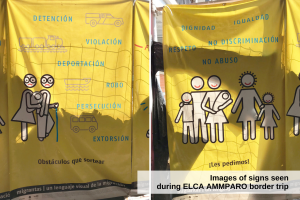URGENT NEED FOR CONGREGATIONAL ACCOMPANIMENT OF AFGHAN REFUGEES
At the end of August, we watched with anguish the fall of Afghanistan’s government and the evacuation of thousands of Afghan refugees to U.S. military bases called safe havens. Presiding Bishop Elizabeth Eaton reminded us of the critical need for Evangelical Lutheran Church in America (ELCA) engagement:
“Afghan families coming to the United States will need support for months, not just for days. And we need to call on our congregations to be sponsoring entities for the months to come. Join us in supporting the ‘long welcome’ for these families.”
Not since World War II, when Lutheran congregations resettled 57,000 refugees, and the end of the Vietnam conflict has the United States been faced with the formidable challenge of resettling 100,000 refugees who have arrived at the same time.
Since their arrival at safe havens, Afghans continue to be processed and rigorously screened on military bases. These individuals and families are then referred to resettlement agencies before continuing to their next destination. Operation Allies Welcome was created to coordinate their arrival, assistance and resettlement with the help of agencies such as Lutheran Immigration and Refugee Service (LIRS) and Church World Service (CWS) through its affiliates.
In this season of Advent, as we wait for the coming of our refugee Savior who was forced to flee his birthplace as a tender baby, ELCA congregations are urged to help resettle these vulnerable people.
Across the country, many congregations have already begun working with their local resettlement agencies and are sponsoring Afghan individuals and families, in addition to the many asylum-seekers currently being sponsored within the AMMPARO (Accompanying Migrant Minors with Protection, Advocacy, Representation and Opportunities) network. But the need is huge and right now. We call on congregations to see how they can engage in this important effort.
The following resources provide more information about how you and your congregation can get involved:
- An information session will be held February 8, 2022, at 6 p.m. Central time
- Local organizations, such as Lutheran social service agencies or other resettlement affiliates, are great resources for congregations looking to meet the needs of refugees in their communities.
- The Refugee Council USA has posted a map that pinpoints local resettlement agencies, including Lutheran social service affiliates, which may direct you to volunteer opportunities.
- The Reception & Placement Affiliate Directory provides a detailed state-by-state listing of resettlement agencies.
The ELCA has long and historic ties to LIRS and CWS, two of the nine resettlement agencies in the United States.
The ELCA and LIRS are working closely on resettlement in five U.S. cities. LIRS has resettlement operations in 53 cities across the country. The Rev. Rafael Malpica Padilla, executive director of Service and Justice, will convene ELCA bishops to see how each synod can support resettlement.
CWS is focusing its efforts in additional cities around the country where it has affiliates and a program of remote refugee resettlement, which will allow every congregation, no matter how far from a resettlement agency, to get involved in this important work.
In addition to synod and congregational accompaniment, the ELCA has provided a $77,250 grant to ACT Alliance / Community World Service Asia to provide emergency cash assistance to 9,000 Afghan families in-country and those at the border of Pakistan. Contributions can be made through Lutheran Disaster Response’s Afghan Humanitarian Crisis effort.
In this Advent season, we urge all ELCA congregations to follow our Lord’s call to welcome the stranger by joining this important effort and taking steps to welcome refugees.


